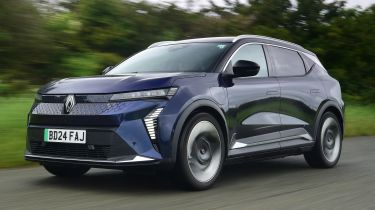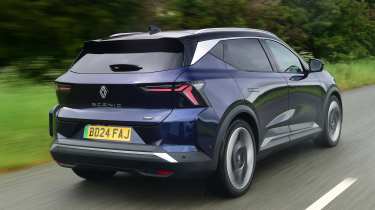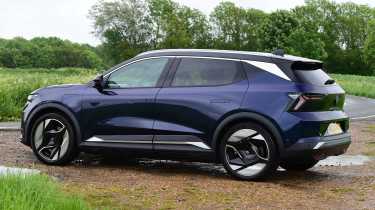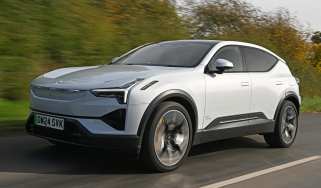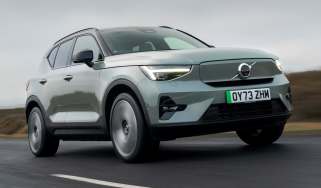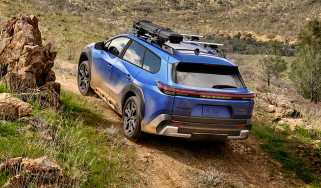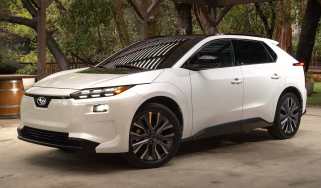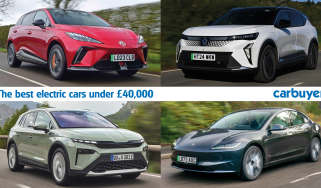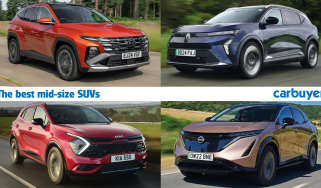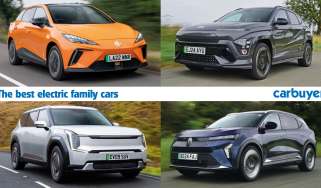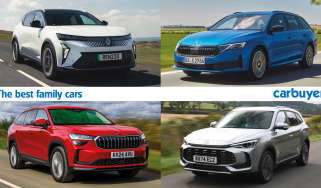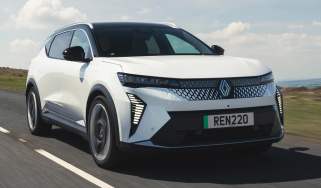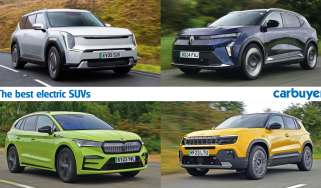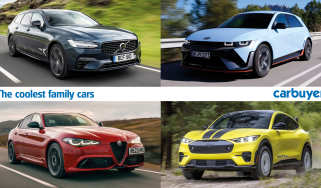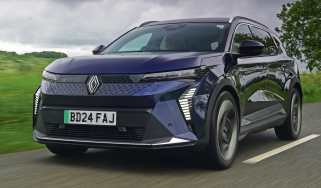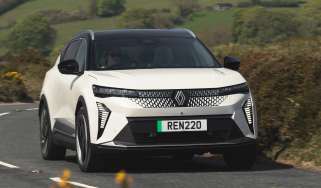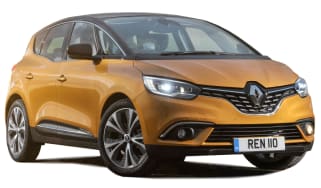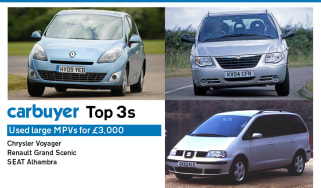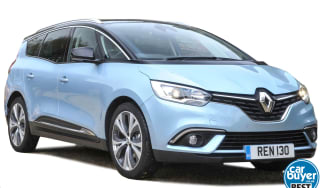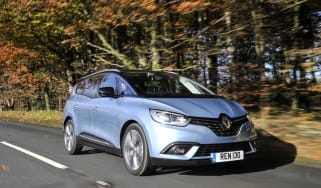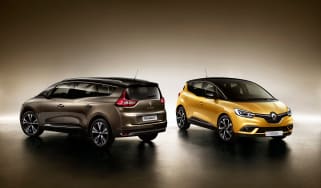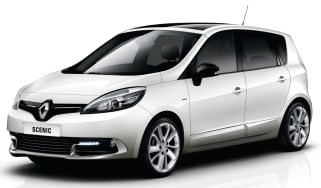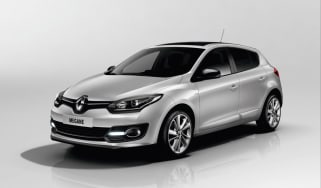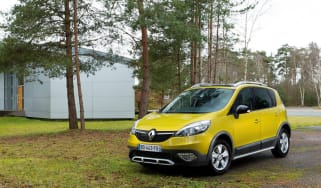Renault Scenic review – family-friendly electric SUV with impressive range
“The reinvented Renault Scenic is a compelling electric SUV with a great driving range and lots of family-friendly features”
Pros
- Impressive range
- Excellent infotainment
- Lots of room
Cons
- So-so acceleration
- Awkward loading lip
- Poor Renault Driver Power result
Verdict – is the Renault Scenic a good car?
Forget the old Renault Scenic people carrier, the name may be the same, but it’s been reinvented as a fashionable electric SUV with an impressive 379-mile range. Not only can it tackle almost any road trip, there’s also plenty of space and kit for its passengers to enjoy the ride, and pack their gear in the huge boot. That's why we named it the Best Family Electric Car for 2025. We were impressed with its intuitive Android-based infotainment system, and neat touches like tablet screen holders and chargers for the back seats that should help keep kids entertained. Low monthly costs on PCP finance deals help the Scenic to nudge ahead of many rivals, too.
Renault Scenic models, specs and alternatives
You may have fond memories of the old Renault Scenic MPV, but as fashions change, so do the cars we drive. Few are impacted as much as this car, which has not only morphed into an SUV, but also ditches combustion engines in favour of an electric motor and battery.
 Top 10 best electric SUVs – the ones to buy in 2025
Top 10 best electric SUVs – the ones to buy in 2025
It’s a logical step, and places the Scenic squarely above the smaller Renault Megane – which has also become an electric crossover in its latest outing. The Renault ZOE supermini is also being replaced with a smaller Renault 5 and Renault 4, along with an affordable Twingo city car in an impressive EV lineup beneath the Scenic.
More reviews
The biggest Renault EV yet also jumps into quite a competitive class, with a growing number of mainstream rivals like the Nissan Ariya, Volkswagen ID.4, Hyundai Ioniq 5 and Tesla Model Y, along with upmarket contenders such as the BMW iX1 and Audi Q4 e-tron. Such radical changes have also seen the Scenic’s price shoot up to around £37,000, but this is still competitive against its new set of rivals.
While its new positioning might sound like a tough gig, Renault shouldn’t be underestimated. After all, its ZOE EV arrived way back in 2013 and became the top-selling electric car in Europe. That has furnished the French outfit with lots of data and knowledge about electric cars and their owners. Indeed, the Scenic comes with a big 87kWh battery, for an impressive 379-mile range. That’s not far off what most drivers will expect from a tank of petrol, and Renault will be hoping that the Scenic can help make the term ‘range anxiety’ a thing of the past. If you don’t travel long distances often, a more affordable 60kWh battery is also available for the entry-level Techo trim.
With 217bhp from its front electric motor, the Scenic also has plenty of punch for your average family SUV driver. It’s smooth – with three different driving modes to adjust how the car feels when you hit the accelerator – and there’s enough in reserve for overtaking and joining faster roads.
While it might boast a higher level of recycled material than most previous Renault’s, the interior feels pleasant and of a high quality. You’d certainly struggle to tell that most ‘leather’ surfaces are artificial, and once on the move the interior is hushed and cocooning from the outside world.
We’re already big fans of the Android-based infotainment in the Renault Austral, and the setup in the Scenic appears to be even better. It uses Google Maps for navigation, suggests chargers along your route, and important shortcuts can always be easily found at the bottom of the screen. There’s even a button to quickly customise safety features to the driver’s preference with one press – solving a common niggle in modern cars with overly nagging driver aids that are difficult to switch off.
|
Trim levels |
Power options |
|
|
Range, charging & running costs
The Renault Scenic E-Tech comes with either a 60kWh or 87kWh battery, with the former serving up a competitive range and starting price. The bigger battery is more expensive, but its official range of up nearly 380 miles is impressive if you spend time driving further afield. Charging at up to 150kW results in speedy top-ups and running costs are hammered down by a low Benefit-in-Kind band for company car drivers, free VED (until April 2025) and reasonable maintenance and insurance costs. Read more about the Renault Scenic's range, charging & running costs...
Electric motors, drive & performance
With either 168bhp or 217bhp and front-wheel drive, the Renault Scenic doesn’t offer the neck-straining acceleration of the Tesla Model Y. Instead this is a balanced and family-focused machine, with smooth acceleration and suspension designed to soak up most of the worst imperfections. Read more about the Renault Scenic's electric motors, drive & performance...
Interior & comfort
There’s a modern feel to the Scenic’s interior, no matter which trim level you pick. Even the entry-level Techno gets large alloy wheels, big infotainment screens with Google-based software and features like heated seats and a wireless charging pad. It’s a comfortable car to cruise around in too, although there’s quite a bit of tyre roar at high speeds. Read more about the Renault Scenic's interior and comfort...
Boot space, practicality & dimensions
The Renault Scenic is a five-seat family SUV that uses a stretched version of the building blocks first seen in the smaller Renault Megane E-Tech. It’s spacious for front and rear occupants, so there’s plenty of space for most families, and visibility is good too. The boot measures a generous 545 litres behind the back row of seats, or 1,670 litres with them folded down. Read more about the Renault Scenic's boot space, practicality & dimensions...
Reliability & safety
Renault has a good reputation for safety and the Scenic is packed with advanced safety kit to help prevent collisions. While it’s too early to judge the Scenic’s reliability, Renault has some work to do according to our most recent Driver Power customer satisfaction survey, coming a lowly 29th out of 32 manufacturers. Read more about the Renault Scenic's Reliability & safety...
Renault Scenic alternatives
The Renault Scenic enters into a highly competitive area of the market, with rivals from both mainstream brands and more upmarket manufacturers. If you aren’t quite ready to make the switch to an EV – or lack convenient access to a charger – there are also plenty of hybrid SUVs available.
Mid-size electric SUVs
The best electric SUVs aren’t short of appealing features, but none can quite match the range of the Scenic if you often head further afield. It’s also got one of the most spacious cabins and most user-friendly infotainment systems.
Mid-size hybrid SUVs
While they don’t offer the dramatically reduced running costs of an EV, for versatility the hybrid SUVs listed here still appeal. That’s especially the case if you’re a private buyer in need of an affordable model that can cover long distances at the drop of a hat.
Should you buy a Renault Scenic?
Renault has real pedigree when it comes to electric cars, so we don’t say it lightly when we think the Scenic is its best EV to date. By extension, that also means it should definitely be on your shopping list if you’re after a zero-emissions family SUV.
It might not be the quickest or sportiest model, but if that’s of little concern, the Scenic E-Tech feels superbly well thought out for families, with smooth responses and a comfortable ride – we've even named it the Best Family Electric Car for 2025. Both battery sizes hold appeal, and the larger capacity packs an impressive range if you regularly take longer trips. It’s also pretty quick to charge thanks to its 150kW top-up speeds.
Equipment levels are good and the cabin is attractive and spacious, with a very easy to use Google-based infotainment setup. While it lacks seven seats, there’s plenty of room for five occupants and a generous 545-litre boot.
What is the best Renault Scenic for low running costs?
There’s not really too much in it, so which battery size you pick will come down to how often you need to take long trips between charging stops. For most owners with a home wallbox, the smaller battery will suffice and it costs around £3,500 less to purchase, but this does limit you to the Techno trim.
What is the best Renault Scenic for families?
It’s impressive how much tech comes as standard with the Techno trim, so it’s only really worth upgrading to a higher grade if you particularly want an extra feature like the Iconic’s clever panoramic sunroof or Harman Kardon stereo.
How we tested the Renault Scenic
We first tested the Renault Scenic in Europe in November 2023, before getting behind the wheel on British roads in May 2024. We also put it head-to-head against the Ford Explorer in autumn 2024.
Which Is Best?
Cheapest
- Name160kW Techno 87kWh Long Range 5dr Auto
- Gearbox typeAuto
- RRP£36,985
Most Economical
- Name160kW Techno Esprit Alpine 87kWh Long Range 5dr AT
- Gearbox typeAuto
- RRP£39,985
Fastest
- Name160kW Techno 87kWh Long Range 5dr Auto
- Gearbox typeAuto
- RRP£36,985
